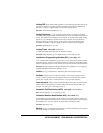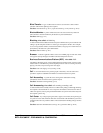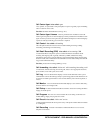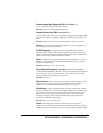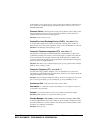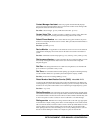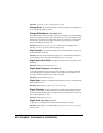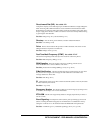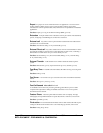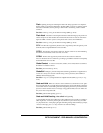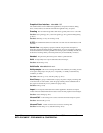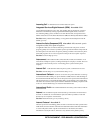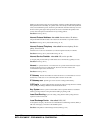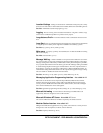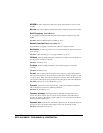
GLOSS-11
BETA DOCUMENT - PRELIMINARY & CONFIDENTIAL
Direct Inward Dial (DID) Also called: DID
A telephone company service that assigns up to 50 different numbers to a single analog line.
When answering calls, DID information is used to determine which number the caller
dialed and then to deliver the call to that number. Strata CS uses DID to assign each user a
unique 7-digit phone number, so callers can dial it to reach a user directly without having
to go through an auto attendant.
See also: analog line (p. G-3), auto attendant (p. G-3)
Directory A list of names, phone numbers, and other related information.
See also: voice mail (p. G-26)
Driver The low-level software that provides an API to hardware. The drivers for the
Dialogic boards are required to run Strata CS.
See also: Dialogic driver (p. G-10)
Dual Tone Multi-Frequency (DTMF) Also called: DTMF
The touch-tone signaling format used by home or business touch-tone phones.
See also: Multi-Frequency (MF) (p. G-18)
E&M Signaling The most common supervisory signaling protocol used to
interconnect PBXs or to connect a PBX to a T1 carrier.
See also: private branch exchange (PBX) (p. G-20), T-1 (p. G-24)
E-Mail Notification A Strata CS feature that sends e-mail messages to users when
they receive new or urgent voice messages. E-mail notifications can include voice
messages attached as .WAV files.
See also: WAV file (p. G-27)
E1 The European version of a T1 line. Contains 30 channels (while a T1 has 24). Encoded
in A-law instead of µ-law format.
See also: T-1 (p. G-24)
Emergency Number The number to dial to access the emergency reporting service
in a location, for example, is 911 in the United States.
ETSI-GSM The IP codec supported by Strata CS. Largely superseded by G.729A, it
runs at 13.2 kbs.
Event Signaling How telephone actions (that is, pick up and hang up) and events
(that is, incoming call and line dropped) are communicated on a robbed-bit T1 line by
setting the A or B bits on or off. Defined in Strata CS Robbed Bit T1 Experimenter.
See also: A and B bits (p. G-1), robbed-bit signaling (p. G-22), T-1 (p. G-24)



